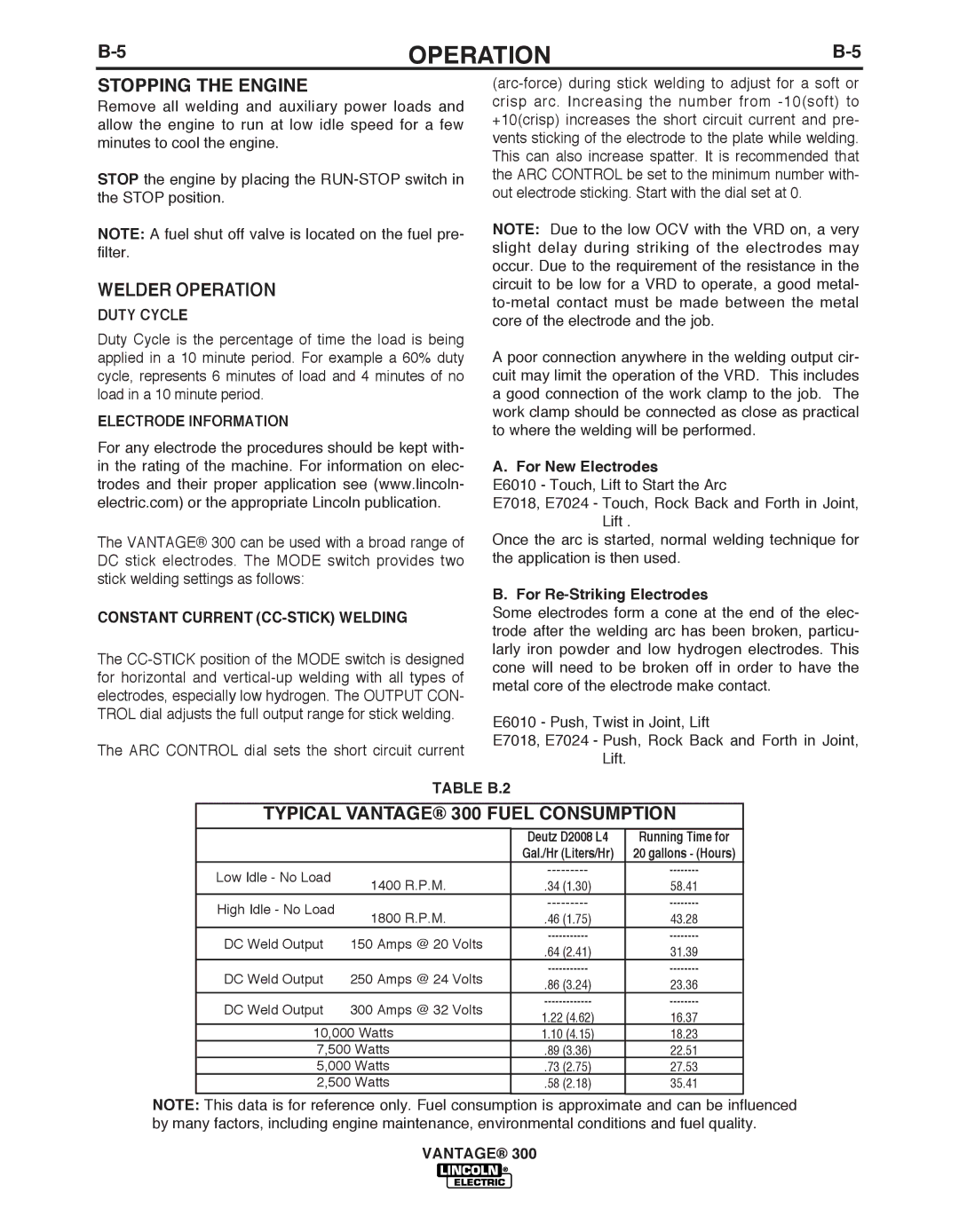
OPERATION | ||
|
|
|
STOPPING THE ENGINE
Remove all welding and auxiliary power loads and allow the engine to run at low idle speed for a few minutes to cool the engine.
STOP the engine by placing the
NOTE: A fuel shut off valve is located on the fuel pre- filter.
WELDER OPERATION
DUTY CYCLE
Duty Cycle is the percentage of time the load is being applied in a 10 minute period. For example a 60% duty cycle, represents 6 minutes of load and 4 minutes of no load in a 10 minute period.
ELECTRODE INFORMATION
For any electrode the procedures should be kept with- in the rating of the machine. For information on elec- trodes and their proper application see (www.lincoln- electric.com) or the appropriate Lincoln publication.
The VANTAGE® 300 can be used with a broad range of DC stick electrodes. The MODE switch provides two stick welding settings as follows:
CONSTANT CURRENT (CC-STICK) WELDING
The
The ARC CONTROL dial sets the short circuit current
NOTE: Due to the low OCV with the VRD on, a very slight delay during striking of the electrodes may occur. Due to the requirement of the resistance in the circuit to be low for a VRD to operate, a good metal-
A poor connection anywhere in the welding output cir- cuit may limit the operation of the VRD. This includes a good connection of the work clamp to the job. The work clamp should be connected as close as practical to where the welding will be performed.
A. For New Electrodes
E6010 - Touch, Lift to Start the Arc
E7018, E7024 - Touch, Rock Back and Forth in Joint, Lift .
Once the arc is started, normal welding technique for the application is then used.
b. For Re-Striking Electrodes
Some electrodes form a cone at the end of the elec- trode after the welding arc has been broken, particu- larly iron powder and low hydrogen electrodes. This cone will need to be broken off in order to have the metal core of the electrode make contact.
E6010 - Push, Twist in Joint, Lift
E7018, E7024 - Push, Rock Back and Forth in Joint,
Lift.
TAbLE b.2
TYPICAL VANTAGE® 300 FUEL CONSUMPTION
|
|
| Deutz D2008 L4 | Running Time for |
|
|
| Gal./Hr (Liters/Hr) | 20 gallons - (Hours) |
| Low Idle - No Load |
| ||
| 1400 R.P.M. | .34 (1.30) | 58.41 | |
|
| |||
| High Idle - No Load |
| ||
| 1800 R.P.M. | .46 (1.75) | 43.28 | |
|
| |||
| DC Weld Output | 150 Amps @ 20 Volts | ||
| .64 (2.41) | 31.39 | ||
|
|
| ||
| DC Weld Output | 250 Amps @ 24 Volts | ||
| .86 (3.24) | 23.36 | ||
|
|
| ||
| DC Weld Output | 300 Amps @ 32 Volts | ||
| 1.22 (4.62) | 16.37 | ||
|
|
| ||
| 10,000 Watts | 1.10 (4.15) | 18.23 | |
| 7,500 Watts | .89 (3.36) | 22.51 | |
| 5,000 Watts | .73 (2.75) | 27.53 | |
| 2,500 Watts | .58 (2.18) | 35.41 | |
|
|
|
|
|
NOTE: This data is for reference only. Fuel consumption is approximate and can be influenced by many factors, including engine maintenance, environmental conditions and fuel quality.
